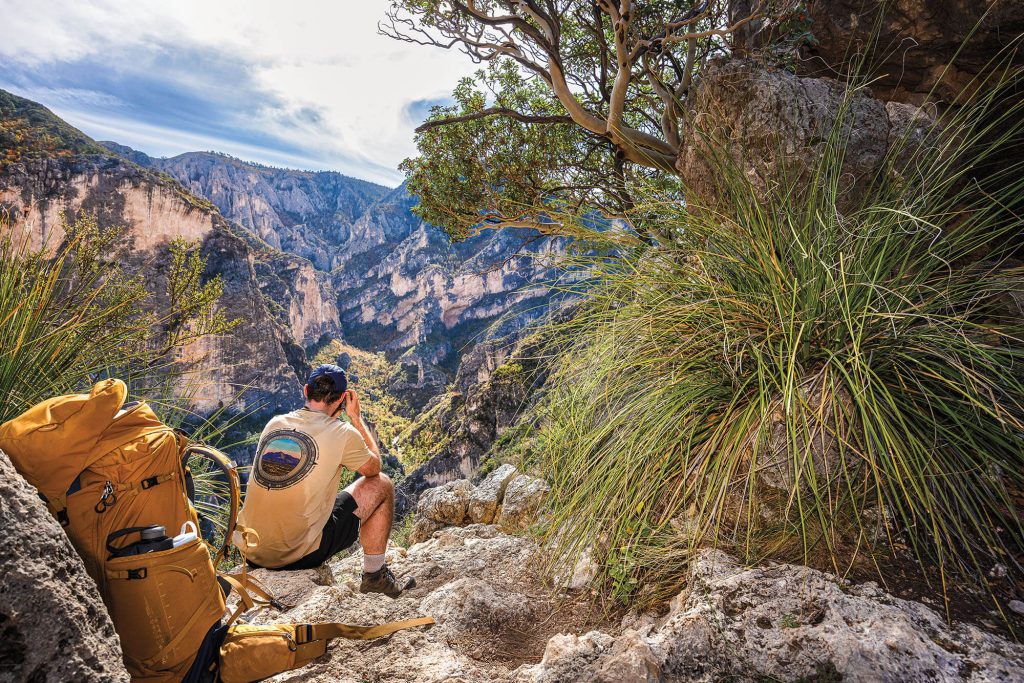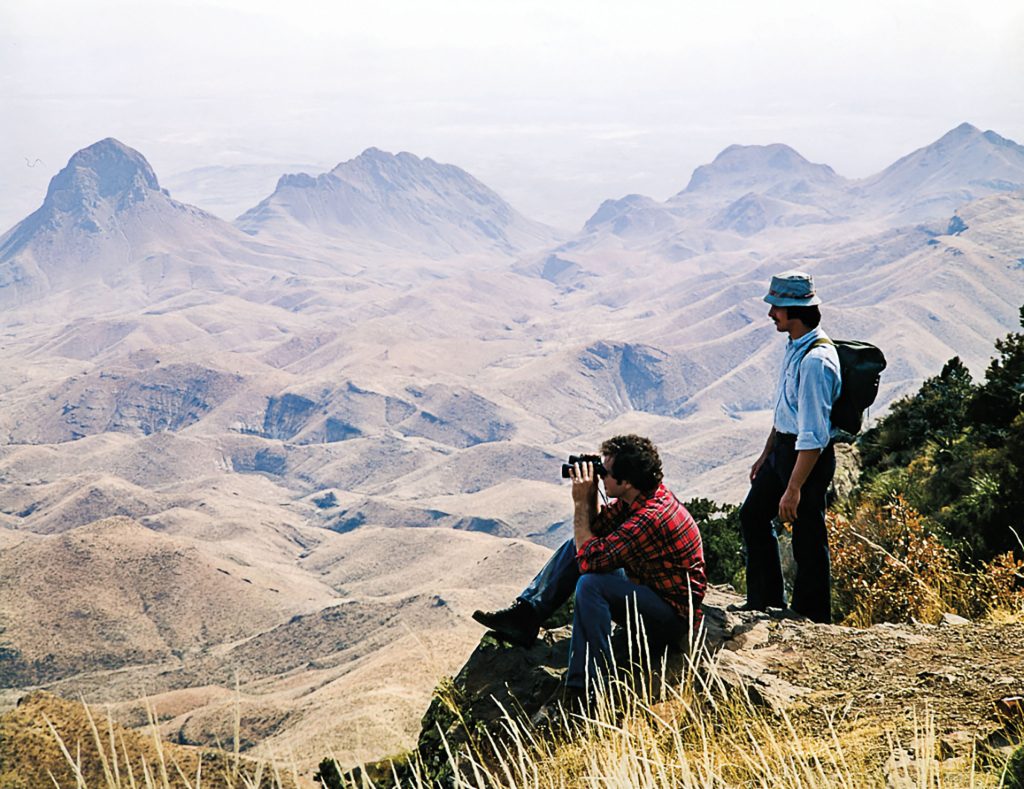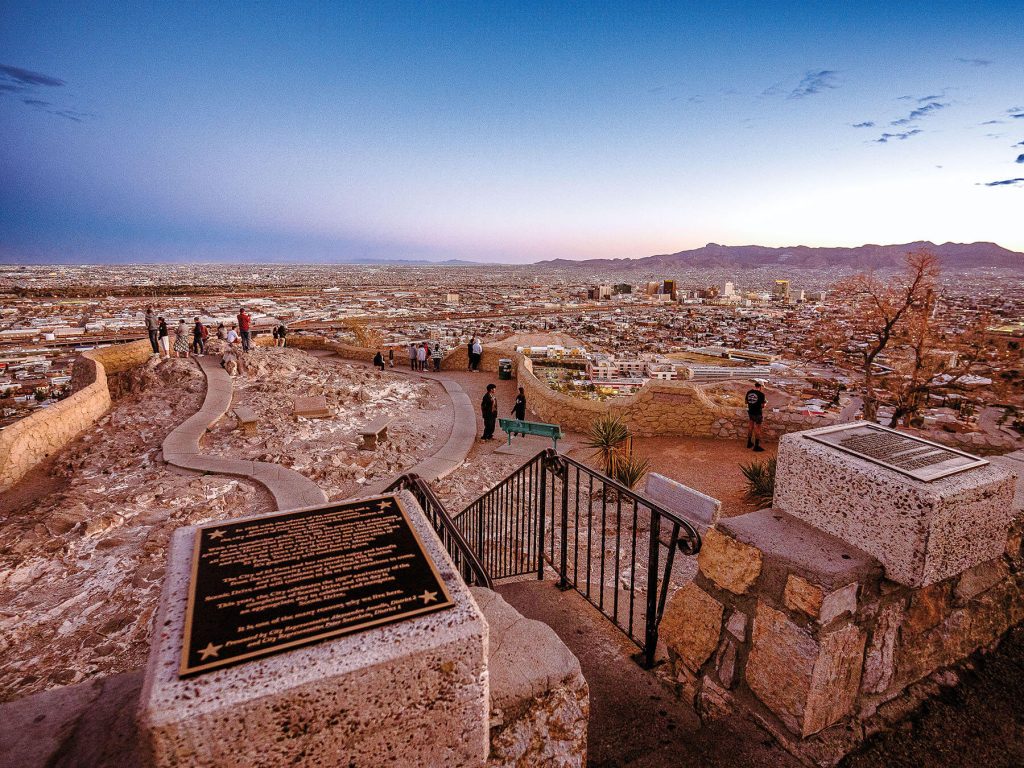Herp To It
Field herpetologists scour Texas in search of elusive amphibians and reptiles
An indigo snake slithers
across the asphalt road—a 5-foot-long creature with shining, blue-black scales and intent, unblinking eyes. It speeds up as I sprint toward it, but it’s not fast enough. A moment later, the nonvenomous snake thrashes powerfully in my hands, its coils flexing around my arms. I’m standing on a dusty Cameron County road, holding Texas’ largest species of snake, filled not with fear but with awe.
I’ve always adored reptiles and amphibians, a broad and rambunctious group of animals that includes everything from turtles to salamanders. I’m delighted by their sometimes bright patterns, the feel of their scales or skin, and their complex ecology. Some people find these cold-blooded creatures to be creepy or scary, which is understandable when it comes to venomous snakes. But actually, most are nonvenomous, and all prefer to be left alone. To me, they’re among the most fascinating creatures that live in Texas.
The state is home to more reptiles and amphibians, collectively, than any other U.S. state. From the semitropical south to the western deserts, Texas’ diverse habitats support 71 species of amphibians and 160 species of reptiles, from alligators to the Texas tortoise.
That bounty of species makes Texas a popular spot for both professional and amateur herpetologists—people who study reptiles and amphibians. Often called “herpers” for short, they comb the wilderness and roadsides for underappreciated but spectacular species, a practice known as “field herping.”
Last summer, I set out across Texas in search of the state’s reptilian riches. In some ways, the trip emphasized the perils native creatures face. The state was baking under high temperatures and a punishing drought, symptoms of ecological and climatic shifts that stress reptiles and amphibians. Habitat loss due to expanding urban development and roadways likewise exacts a heavy toll.
But my experience also underlined the deep and contagious love herpers have for the oft-misunderstood objects of their fascination. Texas is a state packed with reptile species, and you never know what you might encounter.

Central Texas
Sometimes the best way to find reptiles is to park the car, grab a flashlight, and hit the trail for a night hike through the forest. The first stop on my herping tour of Texas is Palmetto State Park—located about 5 miles south of Interstate 10 near Gonzales. There, I meet Romey Swanson, director of conservation strategy at Audubon Texas. It’s 10:30 p.m., and the live oaks press in from the dark, their bark shining under our flashlights. Palmetto fronds cast spiky shadows against the forest floor.
Though Swanson’s day job is dedicated to conserving birds, he’s also a keen appreciator of reptiles. In 2021, he completed a reptilian “Big Year,” crisscrossing Texas in an effort to see as many of the state’s reptiles and amphibians as possible. He ended up with a final count of 178 species, over 75% of the state’s total.
Swanson spends a lot of time working in the Hill Country of Central Texas, which acts as a crossroads for reptile habitat. The area sits at the edge of different geographical zones. Herpers exploring state parks and trails across the region’s patchwork of prairies, scrub forests, and spring-fed woodlands can find coachwhips, ribbon snakes, alligator lizards, and a handful of spiny lizard and racerunner species.
But not all Central Texas landscapes look like the rocky rangeland of the Hill Country. Located on the winding San Marcos River, Palmetto State Park harbors a dense, tropical-like mix of seasonal swamps and vegetation, including its namesake dwarf palmettos, sycamore and cypress trees, and various species of oak tree. When Swanson conducted research for his wildlife ecology master’s degree at the park in 2008 and 2009, during a period of relative drought, he recorded 17 different species of snake, including the elusive timber rattlesnake.
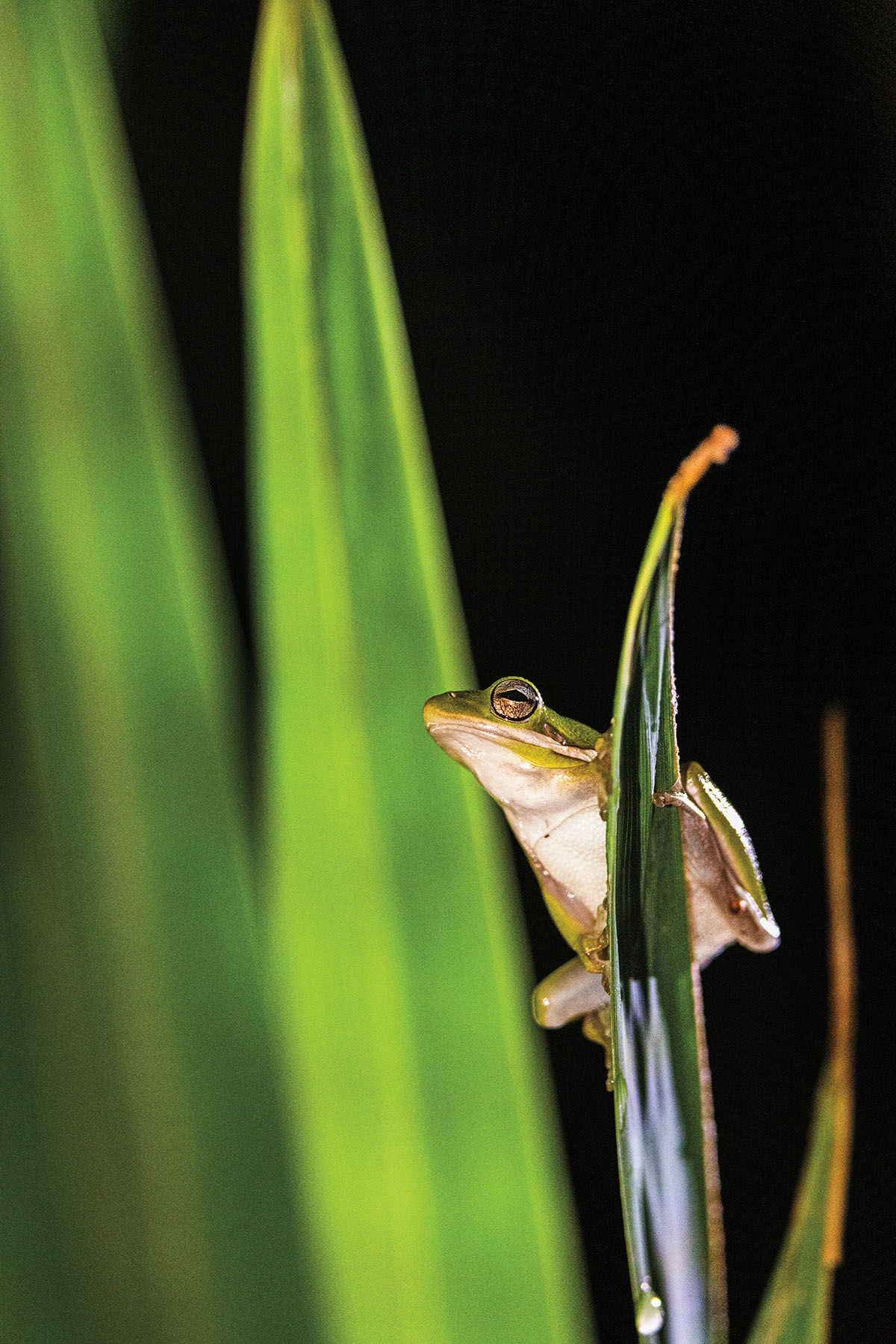
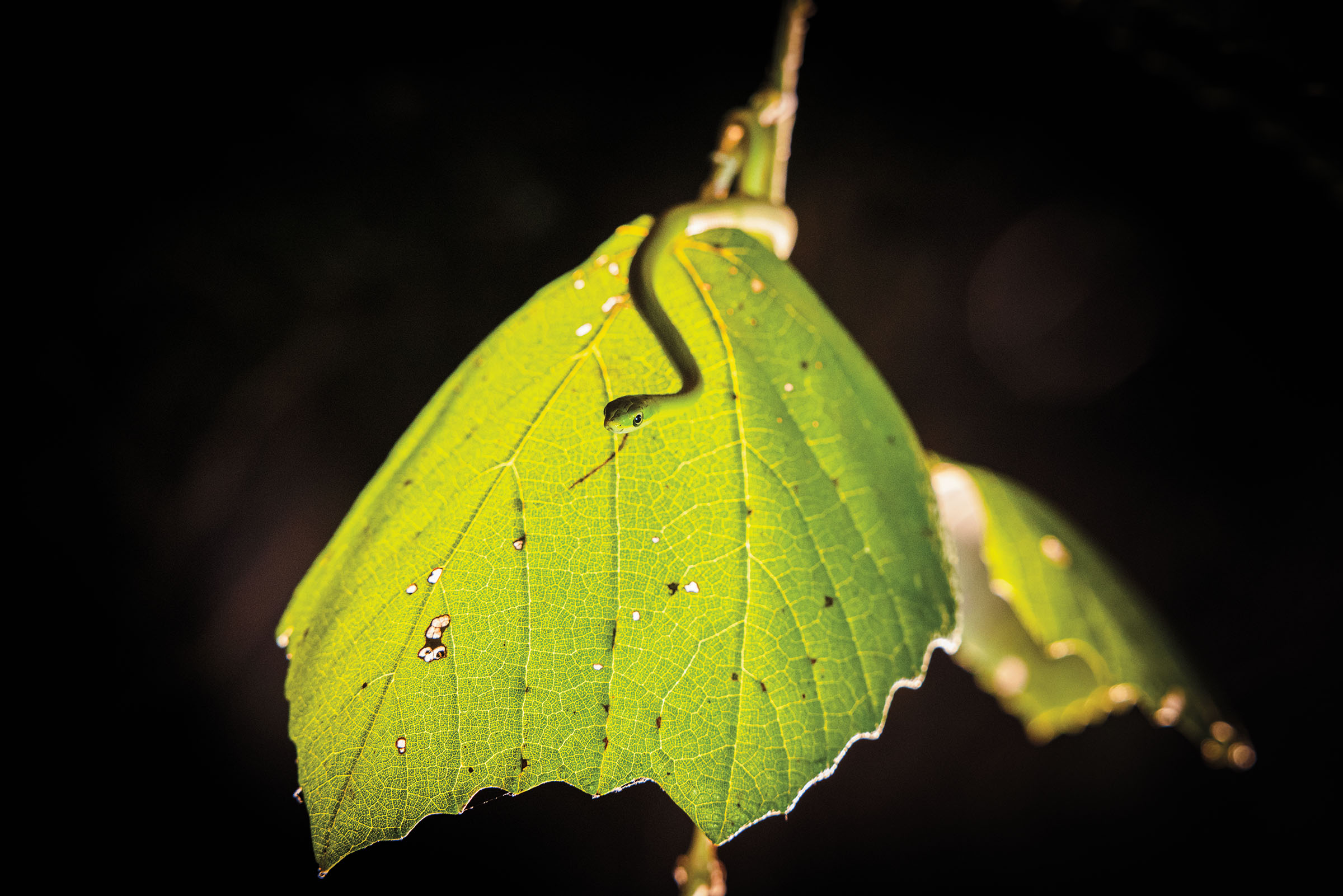
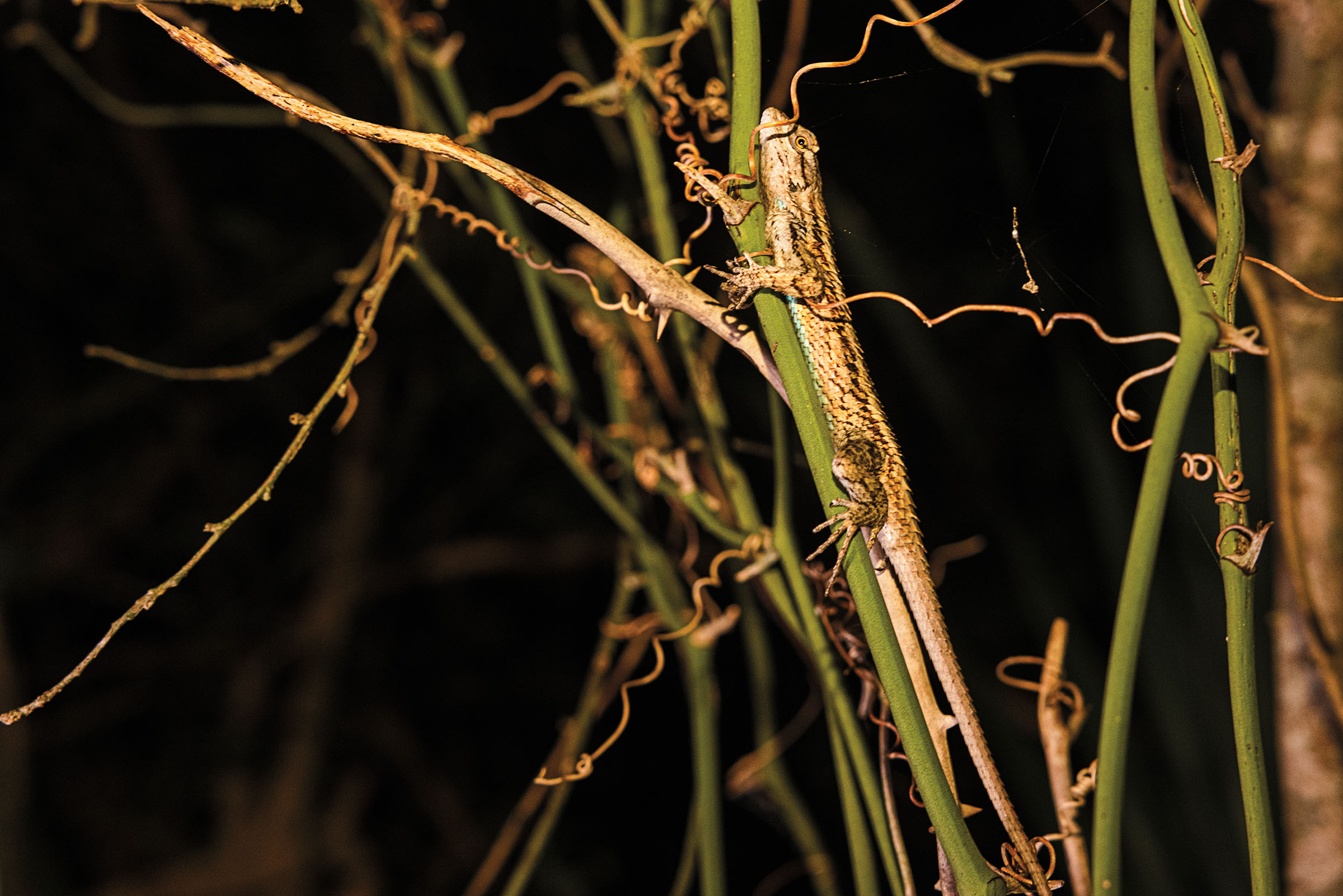
When we visit in August, the park is once again in the grips of drought, its ephemeral ponds evaporated into dry basins amid the palmettos. The leaf litter and dirt beneath several rotting logs are dry, dimming our hopes of finding small-mouthed salamanders. But as the sun falls, the park comes alive. Green tree frogs shrill from the black canopy, and toads chirp in the brush. A large Texas rat snake, its scales reflecting our flashlight beams, slithers through the branches of a tall pecan near the park’s oxbow lake.
Swanson points out a tiny form hanging cradled on a twig in a tangle of vines and branches nearby. It’s a rough green snake, a slender, quick, and harmless species that often hides in dense brush and generally near streams. Its green scales and habit of swaying like a windblown twig usually serve as excellent camouflage, Swanson says. But play a flashlight over one at night, and its belly scales shine brightly. When looking for secretive animals, sometimes all you need is a change of perspective.
Herp Sightings: little brown skink, Gulf Coast toad, green tree frog, prairie lizard, banded water snake, rough green snake, Texas rat snake
Learn More: On Sept. 16, the San Marcos Parks and Recreation Department hosts its annual Snakefessst with guided herp walks, a herp kayaking trip, and presentations on topics like native snakes of Central Texas and how to interact with snakes safely.
sanmarcostx.gov/3695/snakefessst

East Texas
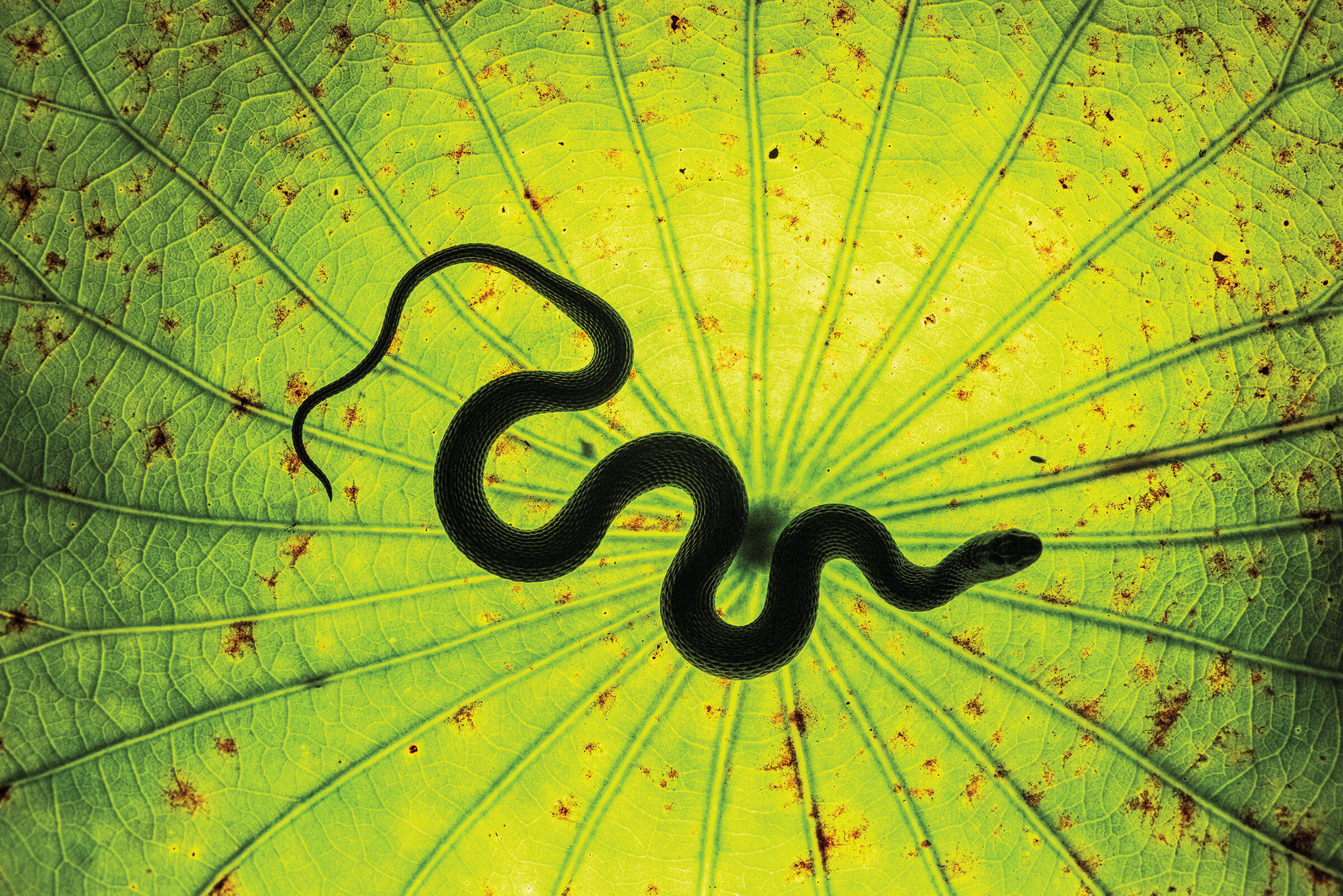
In mid-October, I visit Brazoria National Wildlife Refuge, a 70-square-mile expanse of coastal prairies, salt marshes, and freshwater sloughs along the Gulf Coast about 60 miles south of Houston. The summer drought has lingered into the fall, and Lake Texana is shrunken in its banks. The wetlands are covered in dry thickets of brush and hard packed dirt.
“This is sad,” says Michael Price, a naturalist, snake breeder, and public outreach director for the Lavaca-Navidad River Authority. “This was all underwater a few months back.”
Originally a West Texas herper—he keeps a Texas reticulated gecko in his office at the Brackenridge Recreation Complex in Edna—Price has come to love and respect the reptilian wildlife of East Texas. His company, Wild About Texas, offers classes on venomous animal safety and reptile identification. He also writes the “Wild About Texas” column that runs in newspapers including the San Angelo Standard Times and Jackson County Herald-Tribune. Price rattles off some of his East Texas favorites: tree frogs, bullfrogs, timber rattlers, cottonmouths, water snakes, skinks, and alligators.
“The biodiversity is not high, but the biomass is ridiculous,” Price says of the refuge. “On a good day, you could see 40 snakes, even if it’s only a few species. And you can usually herp year-round.”
In search of a wetter environment, we drive about 40 miles northwest to Brazos Bend State Park. The lakes here are very low but still contain a bit of water. Long, shallow channels wind through the mud flats of Elm Lake, the banks forested by the towering, beached stalks of lilies. Flocks of coots and gallinules swarm and cluck in the shallows, not far from the heads of alligators sitting motionless in the shallows.
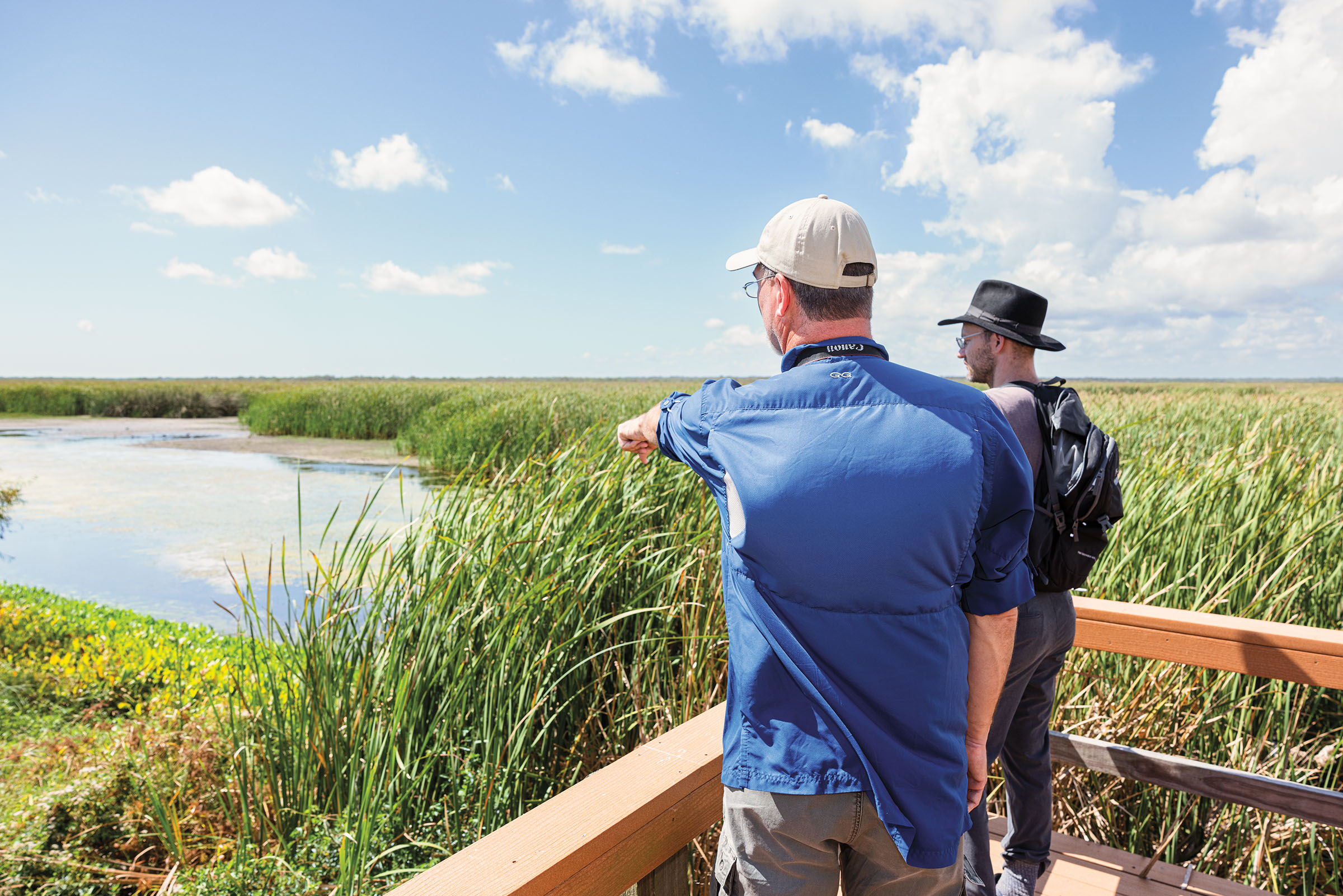
Alligators are the largest of Texas’ reptiles and among the most dramatic, preying on everything from bullfrogs to feral pigs. During wetter times at Brazos Bend, Price says, they often bask right alongside the trails, unconcerned with pedestrians. During the drought, the alligators have fewer wetlands to hunt, but their slow metabolisms enable them to weather tough conditions on surprisingly little food.
As we stand on the Elm Lake loop trail, a sudden splash breaks the shallow channel. Water birds explode into panicked flight, fleeing for the bank. In their wake, a 5-foot alligator hangs in the water, its jaws locked around a struggling gallinule. The alligator swims around with its prize for several minutes before finally swallowing it. From the bank, we can hear the bird’s leg bones snap.
“Wow,” Price says, snapping photographs. “I’ve seen them eat crayfish and frogs. Never anything bigger.”
We walk for an hour afterward without seeing anything. The swampy forests seem suddenly empty. A salt wind blows cool and strong off the distant bay, rustling the Spanish moss in the live oaks. The sun sinks low behind the bare limbs of dead trees.
Finally, on our way back, I spot a cottonmouth snake crossing a caliche path. Contrary to its fearsome reputation, the venomous snake first tries to evade us, before coiling into a neat ball, making no attempt to charge or strike. Our flashlights illuminate the subtle beauty of its scales—a rich palette of browns, reds, and blacks—and the measured flick of its tongue.
“Look at that,” Price says. “They’re not the monsters people make ’em out to be.”
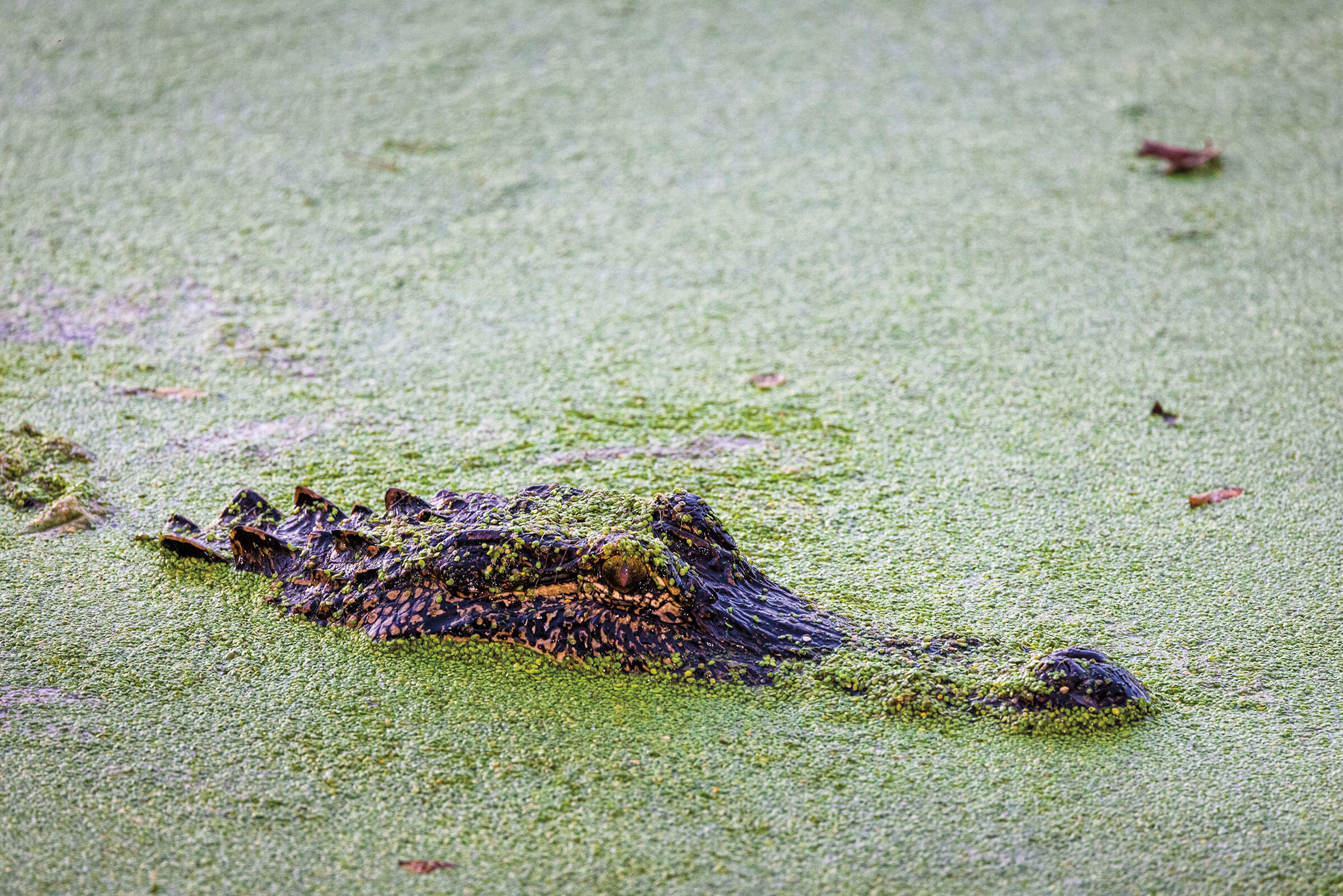
Herp Sightings: Gulf Coast toad, Western ribbonsnake, American bullfrog, American alligator, cottonmouth, glossy swampsnake, green tree frog, Mediterranean gecko
Learn More: The Texana Community Education Center, operated by the Lavaca-Navidad River Authority, displays various reptiles and amphibians from the surrounding forests and holds guided nature walks. 344 Park Road 2, Edna. 361-782-2070;
brackenridgepark.com

West Texas
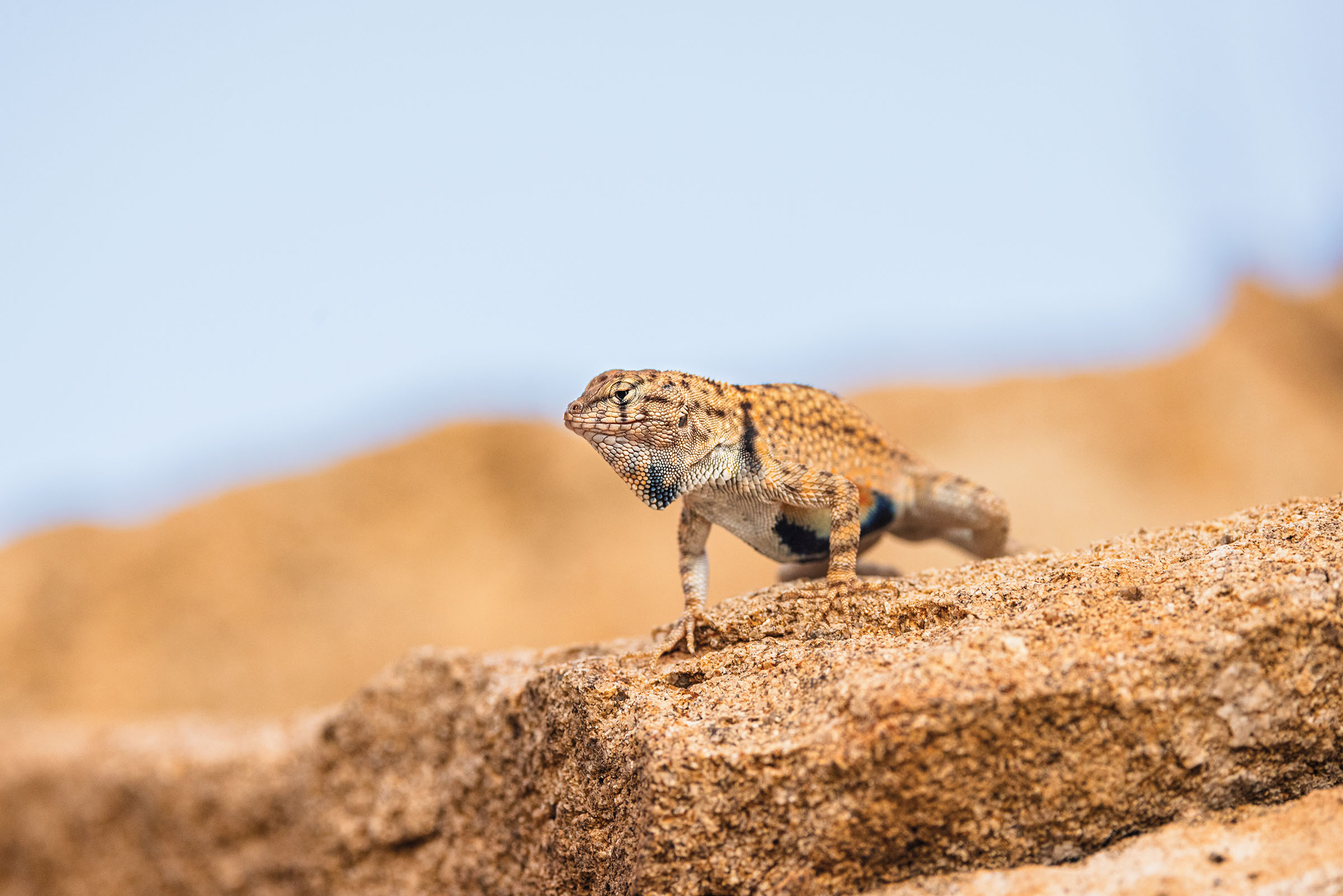
Hoy, the owner of Big Bend Birding & Photo Tours, leads wildlife expeditions all over the world, but the deserts of West Texas are his home base. The desert mountains and rocky canyons contain the state’s greatest diversity of reptiles, including rarities that herpers prize, such as gray-banded kingsnakes.
Despite the number of species in the region, finding reptiles amid the Chihuahuan Desert’s wide-open spaces is a daunting task. Driving at night increases your chances. Many reptiles turn up on roads in the evenings, either crossing to get somewhere else or drawn by the residual heat of the asphalt’s surface. As a result, a well-timed car trip can reveal all kinds of species that might otherwise be tough to see.
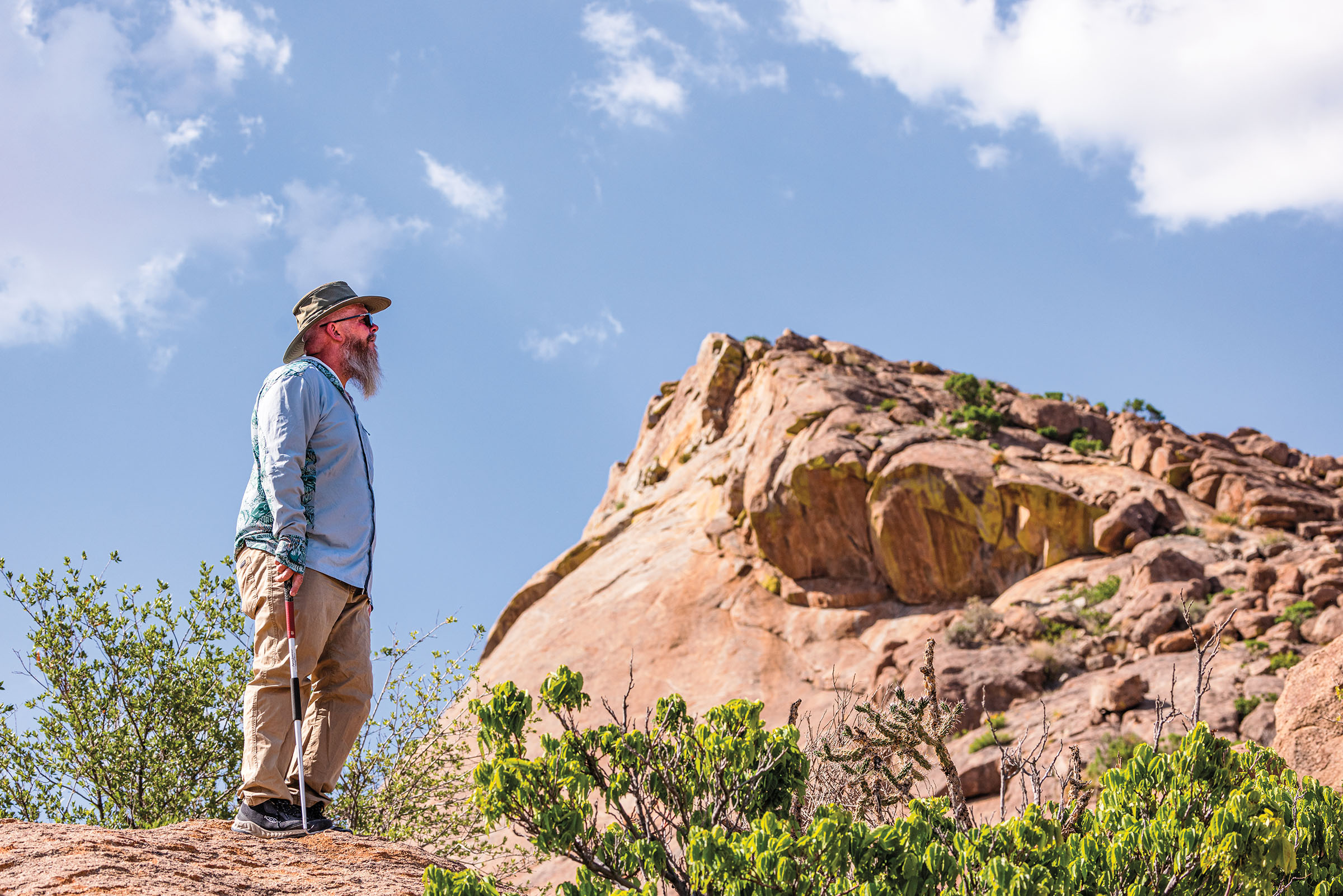
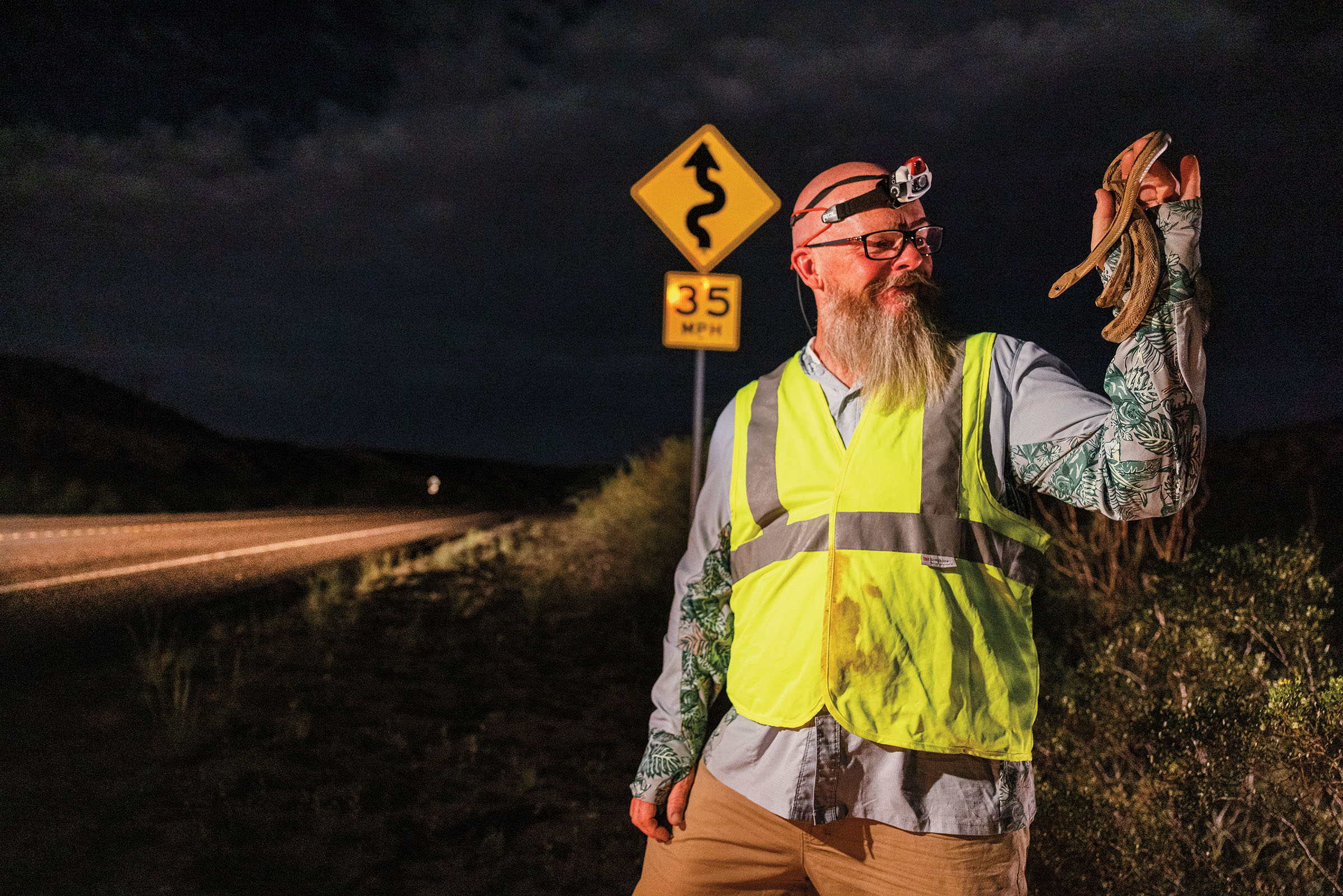
I ask Hoy if we might spot a Texas banded gecko, a shy lizard species. Hoy grimaces and shakes his head. The cool temperatures are working against us. But the bands of rain passing through have lured out other creatures. After coming across a few diamondback rattlesnakes, Hoy hoots with delight as he shines his flashlight across the intricate bands of a Trans-Pecos copperhead. Later, a rainy stretch of ranch road produces several red-spotted toads and a pair of tiny, black-headed snakes on the hunt for centipedes.
Texas law prohibits handling or moving animals in the roadway, which can be frustrating for herpers who wish they could move snakes and lizards away from the danger of speeding cars. It is legal, however, for herpers to walk along roadcuts as long as they’re wearing reflective safety vests. Cliffsides of this kind are favored hiding places and hunting grounds for many desert snakes. Hoy and I walk back and forth along a roadcut outside of Sanderson, pointing our flashlights at the rock. But the stony cliffside remains discouragingly empty of snakes.
Still, the night has one more surprise in store. On US 90, east of Marathon, Hoy pulls another wild U-turn and bundles out of the car. Crossing the wet road is a slinking, 4-inch shape—a Texas banded gecko, a denizen of the desert brush and rocks. This gecko squints suspiciously at us. Our paths intersecting here on the roadside is sheer luck—and the high of that find carries us on the many miles back to Fort Davis.
“It’s a surprise every time,” Hoy reflects. “You never say, ‘Oh, I expected that snake to be there.’ You never know what’s gonna be on that leaf, under a board. You have no idea if you’re gonna see something.”
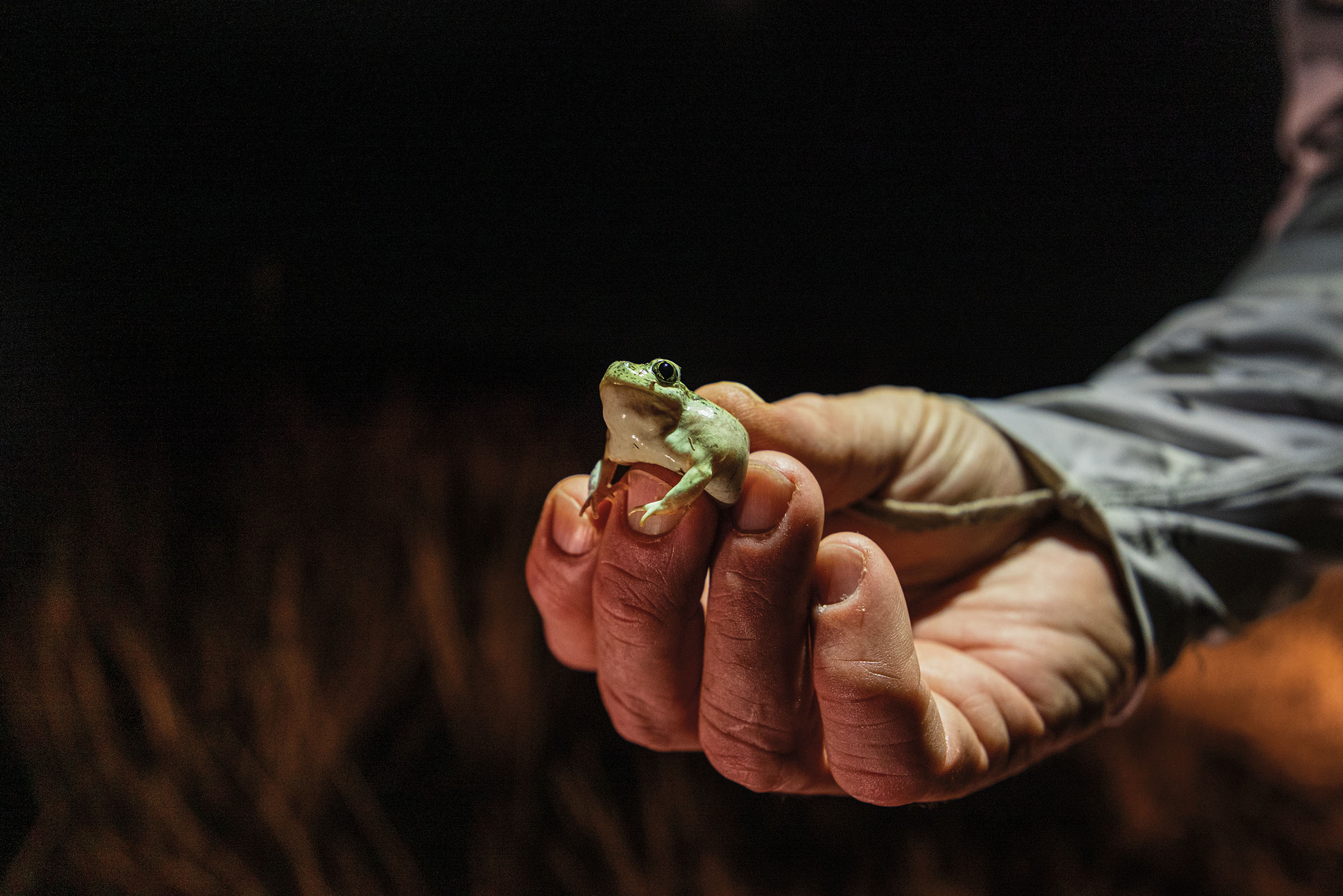
Herp Sightings: western diamondback rattlesnake, cliff chirping frog, couches spadefoot, red-spotted toad, Trans-Pecos copperhead, Texas banded gecko, black-headed snake
Learn More: Lee Hoy’s Big Bend Birding & Photo Tours guides herping trips throughout West Texas. leehoyphotography.com

South Texas
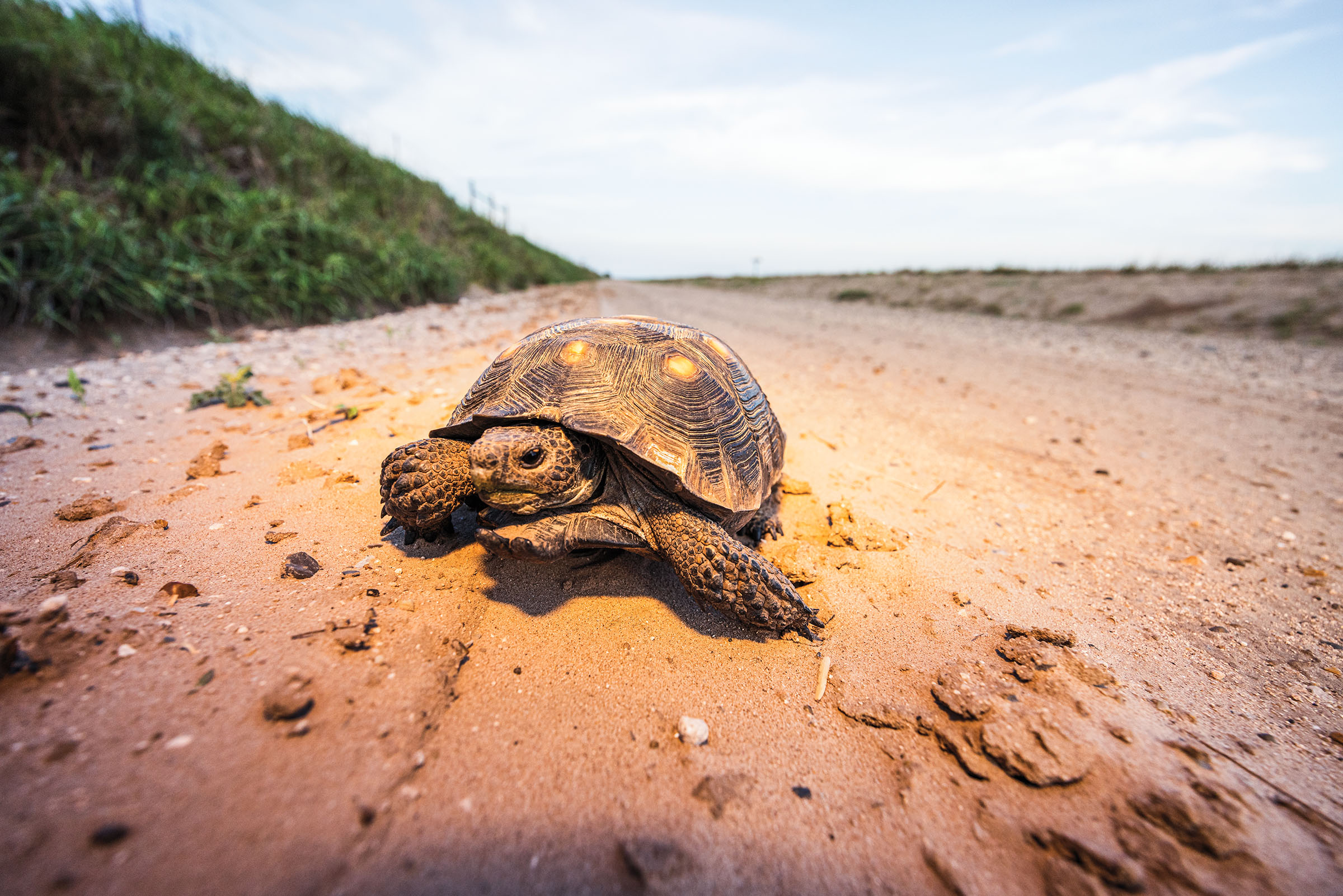
The Lower Rio Grande Valley’s crossroads ecosystem is famous for its diversity of birdlife and opportunities to see birds that live nowhere else in the country. But the region contains scalier treasures as well. For a close-up look, I join Clint Guadiana, curator of reptiles and amphibians at the Gladys Porter Zoo in Brownsville. We embark on a tour of the 557-acre expanse of the Sabal Palm Sanctuary, a nonprofit preserve in Cameron County.
Guadiana, who grew up in Phoenix, Arizona, says he became interested in herping when his family moved to the snake-rich Arizona mountains. He kept snakes at home and volunteered at the Phoenix Herpetological Sanctuary before taking a reptile keeper job at the Gladys Porter Zoo in 2010. The move was an adjustment. In his first few years in the Valley, Guadiana saw little in the way of reptiles compared to Arizona. “It wasn’t until I started paying attention to weather and barometric pressure and dew point that I started having success,” he says.
The landscapes of this part of South Texas are a mixture of seasonal lakes, scrubland, and subtropical forest, inhabited by South Texas specialties like indigo snakes and Texas tortoises, Guadiana explains. Today, agricultural development has chewed away at the region’s wilderness, destroying most of the sabal palms that once covered the region. The wandering Rio Grande has been largely locked down and diverted into farms, drying up some of the resaca ecosystems.
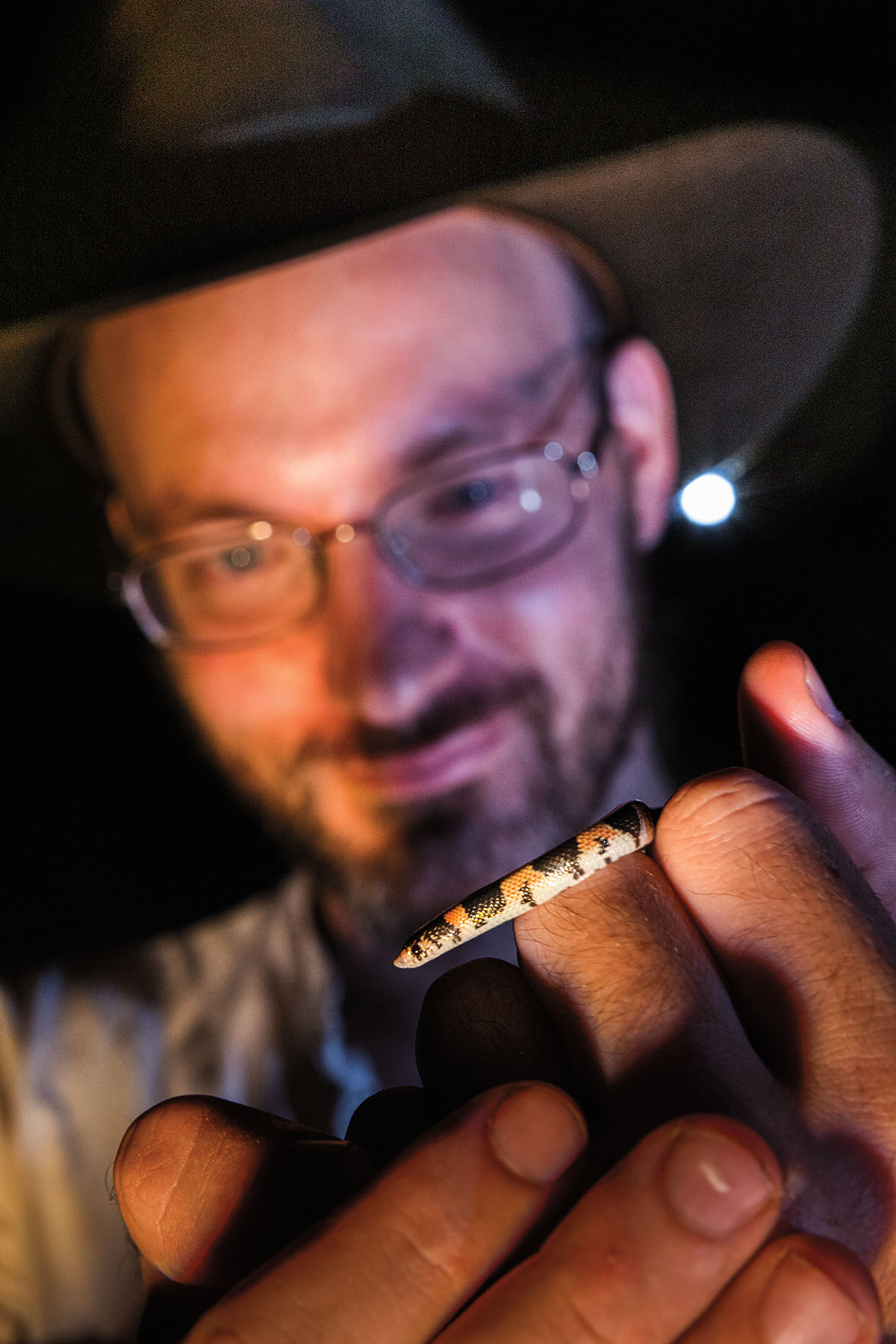
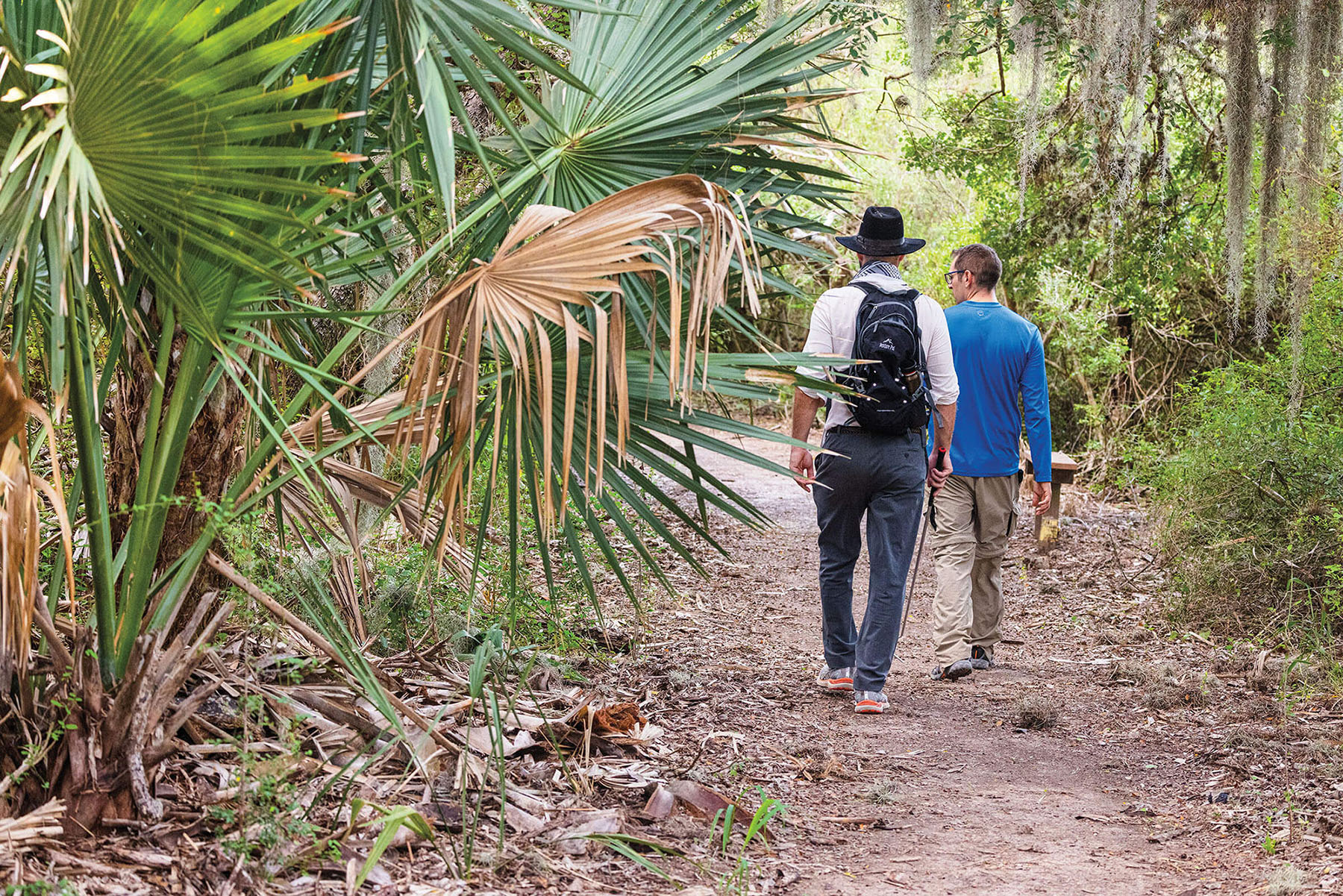
During our trip, however, moisture from recent rains coaxes the animals into action. The night before our Sabal Palm hike, Guadiana takes me for a drive around the backroads of Starr County. Some of what we find is gruesome: Texas tortoises dead on the asphalt, struck by heedless cars. Others are delightful: a shy cat-eyed snake—a handsome, slender animal with a faintly surprised expression—hunting amid the rocks for geckos.
When we arrive at Sabal Palm Sanctuary the next morning, the forest rustles under cool, cloudy skies. Dappled light drips through the canopy, illuminating the palm fronds among the leaf litter. We’re here to see a speckled racer, an opalescent snake common in Central America that reaches the northernmost boundary of its range at the preserve, the last bastion of its palm forest habitat. Sabal Palm Sanctuary is its stronghold in the U.S.
Even within the boundaries of the refuge, speckled racers are famously shy. I have visited several times and never seen them. The cooler conditions are the perfect time to find them, Guadiana says. True to his word, we spot one immediately: a large adult devouring a puffed-up toad in the gardens alongside the park’s plantation house. We spend the next hour walking quietly along the trails, eventually spotting five more racers. Some slip through the brush or raise their heads to regard us in silent curiosity. One slithers up a bank, shimmying its sides in a strange hunting undulation.
It’s a once-in-a-lifetime sight, a glimpse of South Texas’ past. All we have to do is walk quietly, keep our eyes open, and know where—and when—to go.
Herp Sightings: western diamondback rattlesnake, Mediterranean gecko, cat-eyed snake, long-nosed snake, whiptail lizard, spadefoot toad, leopard frog, speckled racer, Texas indigo snake
Learn More: The Herpetarium at the Gladys Porter Zoo in Brownsville features a diverse collection of amphibians and reptiles, including natives such as coral snakes and Kemp’s ridley sea turtles. gpz.org
A beginner’s guide to herping
Keep these tips in mind before you go searching for reptiles and amphibians.
Scan the ground while hiking. Pay attention to sunny spots where reptiles like to bask, and listen for the sound of movement.
Flip logs, stones, or discarded debris to see what’s hiding beneath—but make sure to use a stick and lift them away from you for safety. Always put flipped material back as you found it to preserve habitat.
Road cruising works best on warm evenings after a recent rain. Pick a low-traffic road through relatively undeveloped areas, and drive slowly once the sun starts going down. Wear a reflective vest for safety. Remember, it’s illegal under Texas law to handle reptiles on the roadway.
Know the venomous snakes in your area. If you can’t identify a snake, don’t touch it. If you don’t know if it’s venomous or not, don’t touch it.
If you decide you want to pick up a snake, frog, or lizard, do so carefully; take your photo, and quickly let it go. Handling reptiles is stressful for the animals.
Check out the “Herps of Texas” project on the iNaturalist app for a guide to recent sightings, species’ ranges, and animals that live near you. You can also consult resources like Herping Texas, Michael A. Smith and Clint R. King’s 2018 book about their herping trips across the state.
Meet other herping enthusiasts. Join the Texas Herpetological Society to learn more about research, identification, habitats, and conservation of reptiles and amphibians in Texas. The society hosts field trips and an annual symposium in the fall. texasherpetologicalsociety.org
